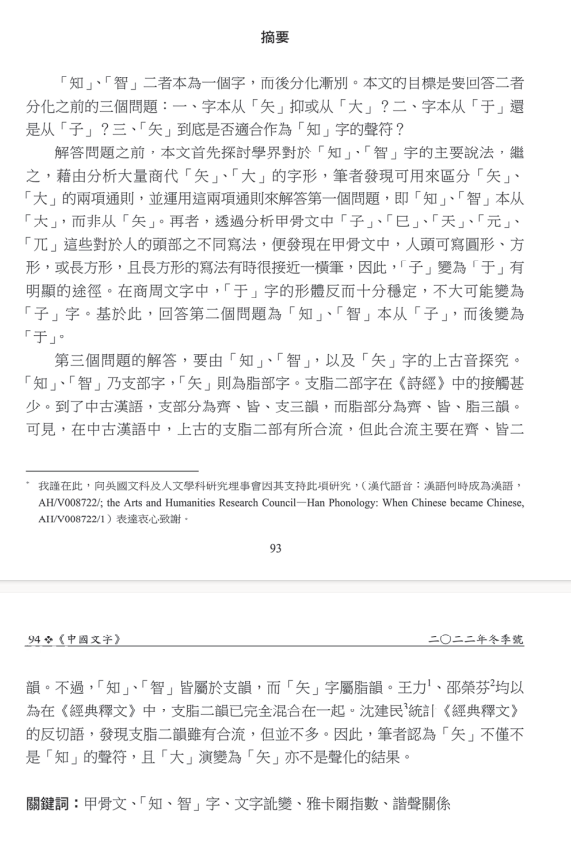
知 “to know” and 智 “wisdom” were originally a single character that split into two some time after the Shang dynasty. There are three major research questions related to the original structure of this character prior to its split. 1. Was it composed of 矢 “arrow” or 大 “adult human; big”? 2. Was it composed of 于 “at; to” or 子 “child”? 3. Is 矢 a suitable sound component for 知 (知 is clearly a good sound component for 智) or not? Before answering these questions, there is a discussion of the opinions of several paleographers as to the origin and evolution of 知 and 智. Next, two guidelines are presented for distinguishing 矢 and 大 in Oracle Bone script, which are based upon the observation of a large number of Oracle Bone forms for these two characters. These guidelines are then applied to question number one, showing that the original form was composed of 大, and not 矢. This is followed by an investigation of the different ways the human head can be written in Oracle Bone script, accomplished by looking at the characters 子 “child,” 巳 (orig.) “child,” 天 (orig.) “head,” 元 (orig.) “head,” 兀 (orig.) “head.” It was discovered that the head can be written as a circle, square, or rectangle. The rectangular form at times is very close to being just a horizontal line. As such, this provides a likely path for 子 to evolve into 于.于, on the other hand, has a very stable form that changes little during the Shang dynasty, making the evolution of 子 into 于 significantly more likely than the reverse. So, the answer to question number two is that 知╱智 was originally composed of 子, and not 于. It was later that 子 became corrupted into 于. To answer the third question, the Old Chinese phonology for 知, 智, and 矢 are considered. 知 and 智 belong to the traditional Zhī bù 支部 rhyme group, while 矢 is in the traditional Zhī bù 脂部 group. These two rhyme groups have very little contact in the Book of Odes (《詩經》). By the Middle Chinese period, the Old Chinese rhyme group Zhī bù 支部 splits into Qí yùn 齊韻, Jiē yùn 皆韻, and Zhī yùn 支韻, while Old Chinese Zhī bù 脂部 splinters into Qí yùn 齊韻, Jiē yùn 皆韻, and Zhī yùn 脂韻. So, there is contact, but it is basically limited to Qí yùn 齊韻 and Jiēyùn 皆韻,while 知 and 智 belongtoZhīyùn 支韻,and 矢 toZhīyùn 脂韻. Wáng Lì4 and Shào Róng-fēn5 proposed that Zhī yùn 支韻 and Zhī yùn 脂韻 had completely merged by the time of the Jīngdiăn shìwén (《經典釋文》), i.e., the Early Middle Chinese period. Shěn Jiàn-mín’s6 statistical analysis of the fǎnqiè spellings in the Jīngdiăn shìwén show, however, that the contact between Zhī yùn 支韻 and Zhī yùn 脂韻 is very slight. Based on the evidence above, the solution to question three is that not only is 矢 not a suitable sound component for 知, the evolution of 大 to 矢 was not motivated by phonological factors.
關鍵詞:甲骨文;「知;智」字;文字訛變;雅卡爾指數;諧聲關係
Keyword: Oracle bone script, the characters 知 and 智, form corruption, Jaccard index, sound series
